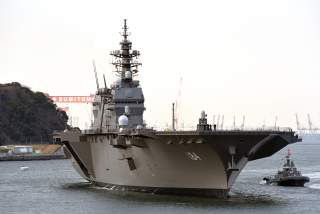There Is Only 1 Thing Stopping Japan from Building Real Aircraft Carriers
Politics.
Japan has decided to refit its Izumo-class light carriers to operate the F-35B stealth fighter. So modified, the Izumos will carry about a dozen F-35Bs each, giving the Japanese Maritime Self Defense Force a small but significant aviation combat capability.
The question now is “what comes next?”
Japan and China
In 2006 Japan laid down the first of two fourteen-thousand-ton Hyuga-class helicopter destroyers at IHI Marine United Yokohama Shipyard. In 2012, Japan laid down the twenty-thousand-ton Izumo, a light carrier in all but name, followed shortly by her sister Kaga. While the Hyugas could conceivably operate the F-35B, there is no indication thus far that the JMSDF intends to retrofit them.
During the same period, China (Japan’s most likely strategic competitor) acquired and refurbished an old Soviet STOBAR carrier, and then built another STOBAR carrier to a modified design. The sixty-thousand-ton Chinese carriers can carry more aircraft than the Izumos, but of older vintage than the F-35B. Between them, Liaoning and her as-yet-unnamed sister can carry some sixty J-15 “Flying Shark” fighters, in addition to helicopters and support aircraft. China’s future plans remain somewhat murky, but it is widely believed that the PLAN intends to build one or two ships to an advanced, conventional CATOBAR design, and then potentially move on to nuclear-propelled supercarriers. J-31 stealth fighters may eventually fly from the decks of these ships.
Long story short, the retrofit of the Izumos represents a real increase in capability for the JMSDF. Nonetheless, China is now several years ahead of Japan, not only in terms of the availability of platforms, but also in the development of naval aviation experience. Japan does not need to compete directly with China over the number of jets launched from flight decks, but China’s increasingly formidable naval aviation force seems to have had some influence on Japanese thinking. So, will Japan decide to compete?
Japan’s Options
Japan is an exceedingly wealthy country with a large, robust, and technologically sophisticated shipbuilding industry. If it wants to supersede the Izumos with larger, more capable carriers then it can do so; the only obstacles are political.
The main questions are what such ships (which for the sake of convenience we will call “Shokaku” and “Zuikaku”) might look like. Japan is unlikely to order a large carrier from a foreign yard, and not just because very few countries can build such ships. Rather, Japan would want to develop and retain the expertise associated with the construction of large, modern aircraft carriers, a project that it has already begun with the Hyugas and Izumos.
Something like the sixty-five-thousand-ton Queen Elizabeth class aircraft carrier is not at all beyond Japanese shipbuilding capabilities. With the F-35B, such a ship would immediately be competitive with, and indeed likely superior to, China’s Liaoning-class aircraft carriers. However, the dependence on the F-35B would limit Japan’s options down the road. Unless Japan decided to develop its F-3 stealth fighter as a STOVL aircraft, the F-35B would be the only plausible shipborne fighter for the operational lifespan of Shokaku and Zuikaku. However, these ships could still operate an array of advanced unmanned aircraft, as well as any F-35B replacements developed by the United States. Experience gained by operating the F-35B with the Izumos would feed directly into a “Queen Elizabeth” style ship. Pilots and crew will develop invaluable experience with landings, takeoffs, and shipboard maintenance that Japan has lacked since 1945.
But unlike China, Japan enjoys the benefit of extensive military and industrial relationships with countries that currently operate aircraft carriers, including the United States and the United Kingdom. Thus, Japan does not necessarily need to take the kind of slow, methodical approach to carrier development that China has taken. Instead, Japan could build Shokaku and Zuikaku as full CATOBAR carriers. It can license or acquire the necessary technology (presumably EMALS launch systems) from the United States, and it could utilize the decks of USN supercarriers to develop the cadre of pilots and aircrew it would need to populate such carriers. If Japan decides to go the CATOBAR route, Shokaku and Zuikaku could become some of the world’s most formidable warships, outside of the Nimitz and Ford class supercarriers.
Although the ships would benefit from the range and power-generation capacity offered by nuclear propulsion, Japan lacks any experience with nuclear warships, even at the submarine level. But the United States operated conventional supercarriers for a very long time, under more demanding global requirements than a Japanese carrier would face. Moreover, a CATOBAR carrier would have the option of flying the F-35C or any other carrier-launched aircraft that Japan could develop or acquire in the future. This would give Shokaku and Zuikaku longer range and heavier punch than a Queen Elizabeth style STOBAR carrier.
Parting Thoughts:
To repeat: the only serious obstacles to Japan’s construction of fleet carriers are political. But political obstacles are still obstacles, and the appearance of Shokaku and Zuikaku would have significant repercussions at home and abroad. Indeed, the existence of such obstacles would seem to demand a gradual approach. Still, the decision to refit the Izumos to fly modern stealth attack aircraft suggests that the current Japanese government is willing to run some risks. There can be little doubt at this point that Japan will someday build a successor class to the Izumo; the only questions are when, and what those ships will look like.
Robert Farley, a frequent contributor to TNI, is the author of The Battleship Book. The views expressed here are his personal views and do not necessarily reflect those of the Department of Defense, the U.S. Army, the Army War College, or any other department or agency of the U.S. government.
Image: Wikimedia Commons.


